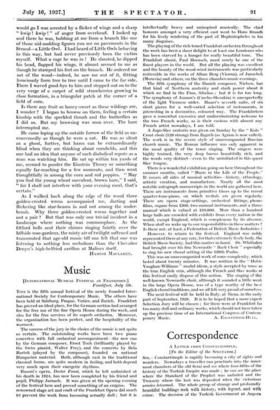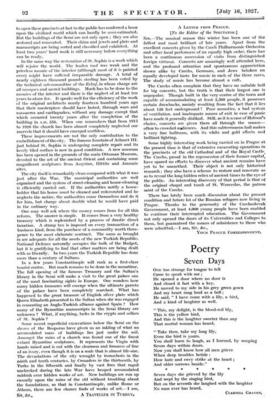Correspondence
A LETTER FRO31 CONSTANTINOPLE.
[To the Editor of the SPECTATOR.]
Snt,—Constantinople is rapidly becoming a city of sights and wonders. Nowadays a traveller can penetrate into the inner- most chambers of the old Semi and see where four-fifths of the history of the Turkish Empire was made ; he can see the place where the Standard of the Prophet was unfurled and the Treasury where the loot was deposited when the victorious armies returned. The whole group of strange and profoundly beautiful buildings reek with history, with legend, and with crime. The decision of the Turkish Government at Angora
to open these precincts at last to the public has conferred a boon upon the civilized world which can hardly be over-estimated.
But the buildings of the Semi are not only open ; they are also restored and renovated. Their china and jewels and plate and manuscripts are being sorted and classified and exhibited. At least two years' hard work is still necessary before everything can be ready.
In the same way the restoration of St. Sophia is a work which will rejoice the world. The leaden roof was weak and the
priceless mosaic of the interior (although most of it is painted over) might have suffered irreparable damage. A total of nearly eighteen thousand pounds sterling has been voted by the technical sub-committee of the Erkaf, in whose charge are
all mosques and sacred buildings. Much has to be done to the mosaics of the interior and there is the neglect of at least ten years to atone for. It speaks well for the efficiency of the work of the original architects nearly fourteen hundred years ago that their masterpiece should have lasted, through wars and
massacres and earthquakes, without any damage except that which occurred twenty years after the completion of the building in A.D. 558. When one remembers that from 1915 to 1926 the church has been almost completely neglected one marvels that it should have emerged scathless.
These improvements are not the only contribution to the embellishment of the city. The famous fountain of Achmet III. just behind St. Sophia is undergoing complete repair and its lovely tiled surface is now in good condition. A new museum has been opened in the grounds of the main Ottoman Museum, devoted to the art of the ancient Orient and containing some magnificent sculptures from Assyrian, Hittite and Aramaic sites.
The city itself is remarkably clean compared with what it was just after the War. The municipal authorities are well
organized and the system of street-cleaning and house-cleaning is efficiently carried out. If the authorities notify a house- holder that his house must be cleaned and redecorated and he
neglects the notice, the authorities come themselves and do it for him, but charge about double what he would have paid in the ordinary way.
One may well ask where the money comes from for all this reform. The answer is simple. It comes from a very healthy treasury which is replenished by a process of drastic direct taxation. A stamp tax is imposed on every transaction of a business kind, from the purchase of a commodity worth three- pence to the most elaborate contract. The sums so brought in are adequate for all the needs of the new Turkish Republic. National Defence naturally occupies the bulk of the Budget, but it is gratifying to find that other matters are being dealt with so liberally. In two years the Turkish Republic has done more than a century of Sultans.
In a few years Constantinople will rank as a first-class tourist centre.. But much remains to be done in the meantime.
The full opening of the famous Treasury and the Sultan's library in the Serai will make a visit to the great palace one of the most fascinating sights in Europe. One wonders how many hidden treasures will emerge when the ultimate garrets of the palace have been completely searched. What has happened to the great treasure of English silver plate which Queen Elizabeth presented to the Sultan when she was engaged in cementing an Anglo-Turkish alliance against Spain ? How many of the Byzantine manuscripts in the Semi library are unknown ? What, if anything, lurks in the crypts and cellars of St. Sophia ?
Some recent superficial excavations below the Semi on the shores of the Bosporus have given us an inkling of what an accumulated mass of buildings lies just under the soil.
Amongst the ruins of a church was found one of the finest extant Byzantine sculptures. It represents the Virgin with hands raised and is cut with the clearness and firmness of line
of an ivory, even though it is on a scale that is almost life-size. The devastations of the city wrought by iconoclasts in the ninth and tenth centuries, by Crusaders in the thirteenth, by
Turks in the fifteenth and finally by vast fires that raged unchecked during the late War have heaped accumulated rubbish over hidden works of art. New buildings are run up casually upon the ruins of the old without troubling about the foundations, so that in Constantinople, unlike Rome or Athens, there are few chance finds of works of art.—I am,











































 Previous page
Previous page